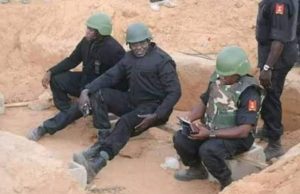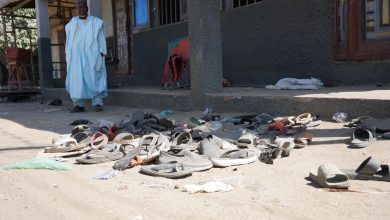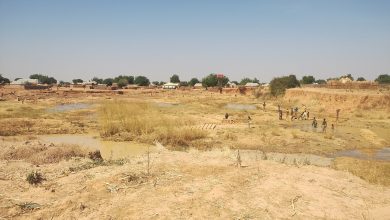Inside The War Front: Nigerian Military Take Out Major Boko Haram Bases
On March 27, 2020, HumAngle exclusively reported the elimination of 18 Boko Haram commanders in a series of air raids in Lake Chad between January and March.
And in April, HumAngle’s independent assessment of the war at the Lake Chad Basin and Sambisa Forest revealed major gains at the war front by Nigeria led Multinational Joint Task Force (MNJTF).
Although the Nigerian military declared that the army killed 343 insurgents in recent combat operations, investigations have established that there were probably heavier casualties suffered by the insurgents between March 18 and May 5.
Reporting the military operations to the media the Coordinator of Defence Military Operations, Maj.-Gen. John Enenche said that “a number of air interdictions were conducted, which led to the destruction of several BHT logistics facilities and compounds housing some of their leaders, including Abu Usamah, and a number of their fighters who were eliminated.”
Impeccable sources knowledgeable about the conflict in the Northeast have revealed the exact locations of the MNJTF and the Nigerian military bombardments of the operational camps in Kwalaram, Ngilewa, Sabon Tumbu, Bukarmairam, Wulgo all in the Marte and Gamboru Ngala axis of Borno State.
Sources familiar with the war disclosed that the fighters fleeing the recent Chadian Military offensive in April were only about settling down in choice locations in Alargo and the Marte flank when the Nigeria Air Force and the MNJTF identified, targeted and bombarded scores of the fighters in air and ground operations.
Independent sources put the casualty figures that resulted from the raids above 500, an indication that the figure given by the military was probably understated.
Analysts who follow the insurgency in the Lake Chad Basin tend to place the recent audio message released by Abubakar Shekau which was exclusively reported by HumAngle in context and conclude that the message mirrors the bloody nose the insurgents are receiving currently in the war fronts.
In the audio message, Shekau alluded to the period of “trial” that his fighters were going through and urged them “not to relent in prayer.”
HumAngle sources have highlighted the loss of “no fewer than 60 war commanders” between March and May, in both the Chadian and Nigerian military operations, an indication that our earlier reported elimination of 18 commanders across Boko Haram factions was lower than the actual numbers.
Sources within the camps of the insurgents said that unlike the case previously, the fighters could no longer move in large groups in daylight. The Air Force, according to the sources, is likely to pick out two out of three large vehicular movements in the day.
Boko Haram and the Islamic State West Africa Province, (ISWAP) convoys have been intercepted by the Nigerian Air Force more regularly now than was the case in 2019. “Fighters now move from one location to the other mostly at night,” said a competent source.
“The offensive of this year can only be compared with what we faced in 2015 and 2016,” said the source, referring to the period when the previous administration mounted an all-out military campaign before the general elections and the sustained momentum by the new administration thereafter.
A serving army captain who spoke with HumAngle in Maiduguri but would not want to be named attributed the renewed advances at the war front to “the current battle strategy of moving reinforcement while troops are still pushing against the insurgents”.
Ground troops have also intensified artillery fire, which combed parts of Alagarno and Sambisa forests.
The military operations in the territories have also resulted in overrunning insurgents’ camps in Durfada, Allafha, Timbuktu, Bulajibi and Gonikurmi in and around Sambisa, sources said, adding that “hundreds” of insurgent fighters died in battles in these camps.
However, sources said that the insurgents might have changed strategies fast by adopting remote operations and desisting from maintaining major operational camps.
A source embedded within the vigilante group corroborated the information on overrun insurgents’ operational locations. However, the local vigilante in the area said, “there are still problems in the operations.”
Boko Haram does not rely on heavy equipment and hardware, so it is easy for them to change locations in a matter of hours, said the source, pointing out that military manoeuvres were different and put the insurgents on their guard.
Informed sources said that it was difficult for the military to maintain a presence in the operational locations they overrun because of the shortage of personnel. In these camps that were overrun, Boko Haram elements have regrouped, they said.
The sources said that in less than one week after Chadian forces chased ISWAP fighters and the sub-faction of Boko Haram away from several fishing islands in Lake Chad, the insurgents regrouped and took up positions in some areas.
HumAngle further learnt that in the Alagarno flashpoint, ISWAP fighters were returning to some of the areas the Nigerian Army successfully overran in the past weeks. The areas are Mattari, Mada, Sansan and Gurzum where soldiers overran and moved on to other battlegrounds.
Sources said there were not many security officials to man and retain every community or camp reclaimed from Boko Haram by either the MNJTF or the Nigerian Army.
“Currently, the situation is one soldier for every five kilometres in the Northeast,” this is what we are dealing with,” said a senior Nigerian government official.
“There are more than 300 camps that host dozens, in some places, hundreds of fighters and their families in territories within Borno and Yobe states,” said Ali Gwange, a local vigilante in Maiduguri.
Gwange added that “only less than half of these camps have so far been attacked by the military.”
Multiple sources point out that there are peculiarities with operational camps used by the insurgents which tend to include secure entry and exit points for them.
The sources explained that such camps tended to provide for them the advantage of surveying any advancing threats from a reasonable distance and provide cover, notably heavy foliage, against airstrikes.
A Boko Haram defector recently disclosed that with every impending military raid on the camps “we quickly leave and return the next day.”
Although there is a positive turn of events in the campaign against the insurgents, sources within the intelligence and diplomatic communities have, however, expressed concern that without resetting the counter-insurgency strategy, the terror groups might still recover and resume their violent campaigns against the military and civilians.
Investigation reveals that one area that remains untapped in the counter-terrorism measures by state actors in Nigeria is a seeming failure to penetrate and crack Boko Haram, and especially ISWAP’s elite Aminiyat group or intelligence unit.
It seems that from their operations the Amniyat elements are well embedded and untracked in several communities in the northeast of Nigeria and the Lake Chad region as a whole, HumAngle learnt.
The Amniyat adherents monitor troop movements and operations, handle logistics, fundraising and assassinations while providing intelligence reports to its central body, sources said.
Persons familiar with the situation are worried about the seeming single focus by state actors on insurgents who carry arms without a corresponding interest on those who always keep the insurgents ahead.

Knowledgeable military strategists also caution that as much as the presence of the Chief of Army Staff Lt.-Gen. Tukur Buratai, in the war front, is boosting troops morale, the war strategy ought to move past the momentary victory into a final push to finish off the insurgents before the rains fully set in.
Field information available to HumAngle suggests that Boko Haram in Southern, Central Borno and parts of Cameroon with its sub-faction in Niger-Nigeria axis can still muster no fewer than 2,000 fighters in spite of their mounting fatalities while ISWAP is in a position to muster nearly double the number.
Without breaching the elite Amniyat and cutting off the insurgents’ economic streams and networks, it might be that the current advances at the frontline would not fully count for much in the end, security experts warn.
Support Our Journalism
There are millions of ordinary people affected by conflict in Africa whose stories are missing in the mainstream media. HumAngle is determined to tell those challenging and under-reported stories, hoping that the people impacted by these conflicts will find the safety and security they deserve.
To ensure that we continue to provide public service coverage, we have a small favour to ask you. We want you to be part of our journalistic endeavour by contributing a token to us.
Your donation will further promote a robust, free, and independent media.
Donate HereStay Closer To The Stories That Matter




